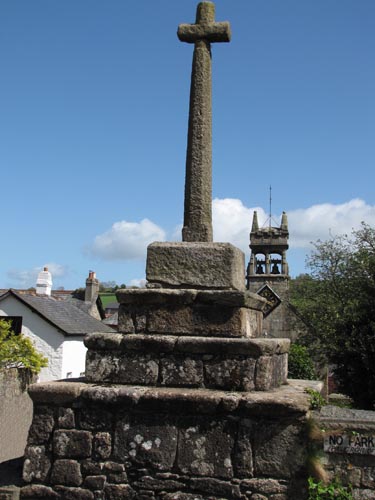 Location:
In the main street of South
Zeal, behind the Chapel of St. Mary. Location:
In the main street of South
Zeal, behind the Chapel of St. Mary.
O/S Grid Ref: SX/65058/93604 Longitude/Latitude (Degrees+/-): -3.91324/50.72633 Map location: Click here to view map. Purpose: Village Cross Size: 9 feet tall. Information: The shaft of this cross is square for about 8 inches above the socket stone. It is then octagonal in shape and is tapered towards the head. The arms and head are separate from the shaft and have been fixed into place with a collar set around the shaft. The shaft is set into a square socket stone, which stands on three large pedestals. Each of these pedestals are formed of small stones and topped off with a number of shaped slabs. The bottom pedestal is by far the larger of the three and has been constructed to form a level platform from the ground, which slopes away quite sharply. The top of the cross stands an impressive 18 feet above the ground below. William Crossing records the story that this cross was repaired in 1838 by a Roman Catholic, John Stansbury, who was a native of South Zeal and a Carpenter by trade. Having previously emigrated to America, he came home on a visit to find the cross in a sorry state. He took it upon himself to repair the cross and as a memento of his visit he carved his initials and the date into the base of the cross. The villagers took exception to this last piece of work and immediately scratched out his initials. This, in turn, upset John Stansbury and he made a vow that, should he ever return to England in the future, he would never again visit the village of South Zeal. He did, in fact, return again to England about 24 years later but he kept his vow not to visit the village, but stayed at Hennock instead. The marks where the
initials have been scratched out can still be seen to this day.
Nearby is the Oxenham Arms public house which is well worth a visit. The main building, which once belonged to the Oxenham family, dates from the early 16th Century, and parts of it may be even older. The house was built around a prehistoric menhir (standing Stone), which was incorporated into one of the walls of, what is now, the small public room behind the bar. The full height of this stone is not known, but it reaches at least from floor to ceiling. There is another, private, house in the street which is said to contain a similar stone. |